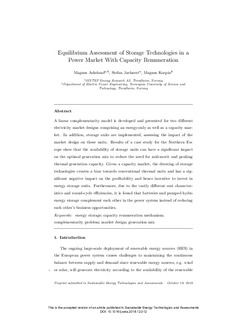| dc.contributor.author | Askeland, Magnus | |
| dc.contributor.author | Jaehnert, Stefan | |
| dc.contributor.author | Korpås, Magnus | |
| dc.date.accessioned | 2019-02-12T17:24:17Z | |
| dc.date.available | 2019-02-12T17:24:17Z | |
| dc.date.created | 2019-01-03T13:44:43Z | |
| dc.date.issued | 2018 | |
| dc.identifier.citation | Sustainable Energy Technologies and Assessments. 2018, 31 228-235. | nb_NO |
| dc.identifier.issn | 2213-1388 | |
| dc.identifier.uri | http://hdl.handle.net/11250/2585106 | |
| dc.description.abstract | A linear complementarity model is developed and presented for two different electricity market designs comprising an energy-only as well as a capacity market. In addition, storage units are implemented, assessing the impact of the market design on these units. Results of a case study for northern Europe show that the availability of storage units can have a significant impact on the optimal generation mix to reduce the need for mid-merit and peaking thermal generation capacity. Given a capacity market, the derating of storage technologies creates a bias towards conventional thermal units and has a significant negative impact on the profitability and hence incentive to invest in energy storage units. Furthermore, due to the vastly different cost characteristics and round-cycle efficiencies, it is found that batteries and pumped hydro energy storage complement each other in the power system instead of reducing each other’s business opportunities. | nb_NO |
| dc.description.abstract | Equilibrium assessment of storage technologies in a power market with capacity remuneration | nb_NO |
| dc.language.iso | eng | nb_NO |
| dc.publisher | Elsevier | nb_NO |
| dc.rights | Attribution-NonCommercial-NoDerivatives 4.0 Internasjonal | * |
| dc.rights.uri | http://creativecommons.org/licenses/by-nc-nd/4.0/deed.no | * |
| dc.title | Equilibrium assessment of storage technologies in a power market with capacity remuneration | nb_NO |
| dc.type | Journal article | nb_NO |
| dc.type | Peer reviewed | nb_NO |
| dc.description.version | acceptedVersion | nb_NO |
| dc.source.pagenumber | 228-235 | nb_NO |
| dc.source.volume | 31 | nb_NO |
| dc.source.journal | Sustainable Energy Technologies and Assessments | nb_NO |
| dc.identifier.doi | 10.1016/j.seta.2018.12.012 | |
| dc.identifier.cristin | 1649673 | |
| dc.relation.project | Norges forskningsråd: 228714 | nb_NO |
| cristin.unitcode | 7548,50,0,0 | |
| cristin.unitname | Energisystemer | |
| cristin.ispublished | true | |
| cristin.fulltext | original | |
| cristin.qualitycode | 1 | |

